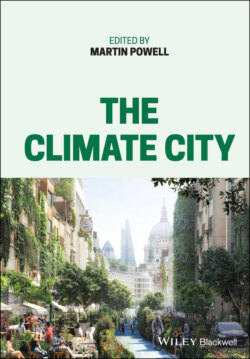Читать книгу The Climate City - Группа авторов - Страница 31
From Bold Leadership Goals to System Change
ОглавлениеTo achieve bold, clear climate goals while managing all the other priorities of the complex modern city, we need leaders that are truly connected: to themselves; to the team around them; to their communities and stakeholders; and to an awareness and appreciation of the entire complex system they are trying to manage and change.
There are many cautionary tales of unintended consequences of trying to do the right thing but in the wrong way – parachuting cats into Borneo in the 1950s is still one of the easiest and quickest to illustrate the point (Figure 1.7).29 Our leaders need to be able to have a curiosity for the potential consequences – both intended and potentially unintended – of various actions by actors within a system and be able to map causal loops before they act.
Figure 1.7 Cats being parachuted into Borneo in the 1950s. (Source: U.S. Air Force / Staff Sgt. Manuel J. Martinez.)
Too often, leaders also try to change a system in a harmful or less-effective way because of their own perspective. Being aware of the “ladder of inference” is powerful (Figure 1.8).30 The flow of our thoughts may build from the bottom of the ladder upwards, but it is vital to realize how our inherent subjectivity filters and creates a unique view as compared to others, even if we all “saw” the same “data” or “had the same experience”. Even more important, the reflexive loop noted in the diagram shows how as we form our beliefs about the world, it further influences and filters what we even choose to “notice”, what data we actually observe and retain from the objective experience that was in front of us.
Figure 1.8 Chris Argyris’s ladder of inference. (Source: Chris Argyris, Overcoming Organizational Defenses: Facilitating Organizational Learning, Allyn and Bacon, 1990. https://books.google.co.in/books?redir_esc=y&id=z7i3AAAAIAAJ&focus=searchwithinvolume&q=%22Ladder+of+Inference%22.)
In cities, leading an ambitious programme like climate action from our own narrow ladders, without taking the time to “get back to the base of the ladder” and truly understand others’ point of view, would not only be unfair; the narrow view will likely be counterproductive to solving the problem at hand. Diversity of thought in the team and in the process not only can keep the individual leader’s ladder more “true” and open to new data and experiences, but also can lead to better outcomes. CityStudio Vancouver, which brings city staff together with students, faculty, and community to design experimental projects that improve the city, has long championed a systems approach that builds time into the process to understand individual perspectives and embrace others’ points of view.
The leaders of the ambitious city need to be depth-finding from a systems perspective. The “iceberg” tool is one of the more famous tools in systems thinking and illustrates effectively how little of the system is observable “above the water-line” (Figure 1.9). As the curious leader continually asks “why”, the learning is increased while the ease of visibility decreases: from readily observable events to patterns of behaviour and results, to underlying structures of a systems, to the mental models and paradigms that created and sustain the system. The iceberg model can be readily applied to a newcomer arriving in a neighbourhood and taking time to understand how “everything works”.
Figure 1.9 Waters Center’s iceberg model. (Source: Adapted from Aki Fukutani (2015), Iceberg..Seeing What’s Below the surface. Retrieved from: https://yourlearningresource.wordpress.com/2015/02/12/iceberg-model/.)
For the ambitious climate leader in the city, architecting a transition to “Net-Zero” would benefit tremendously from a completed “iceberg” diagram, as shown in Figure 1.9 from the Waters Center for Systems Thinking.31
The fourth dimension of systems thinking talent useful for leaders of the ambitious city is connected to action: the ability to analyse and pull the levers to change the system in ways that further the goal of addressing climate change while also increasing equity and social cohesion. Jay Forester defined leverage points “where a small shift in one thing can produce big changes in everything” and are often counterintuitive. Donella Meadows is arguably the definitive source on defining the levers of system change, and the league table reproduced here is drawn from her book:32
Places to Intervene (in increasing order of effectiveness):
1 12. Constants, Parameters, Numbers (subsidies, taxes, standards)
2 11. Sizes of buffers and other stabilizing stocks, relative to their flows
3 10. Structure of material stocks and flows
4 9. Lengths of delays, relative to the rate of system change
5 8. Strength of negative feedback loops relative to the impacts they are trying to balance
6 7. Gain from driving positive feedback loops
7 6. Structure of Information flows
8 5. The rules of the system (incentives, punishments, constraints)
9 4. The power to add, change, evolve, or self-organize system structure
10 3. The goals of the system
11 2. The mindset or paradigm out of which the system (its goals, structure, rules, culture) arises
12 1. The power to transcend paradigms
Interestingly, much better researched and most-often tried are the shallower, less-effective methods, while the more-effective levers are less researched and less obvious. The applicability of “lever-pulling” to managing a city to address climate change is energizing, and would support efforts to increase listening, communication, and genuine understanding as deep paradigm-shifting system change efforts, and not just a box-ticking exercise on the way to “Net-Zero”. “Net-Zero” is likely not to remain elusive unless these “deep” efforts to change beliefs and social structures are part of the plan.
